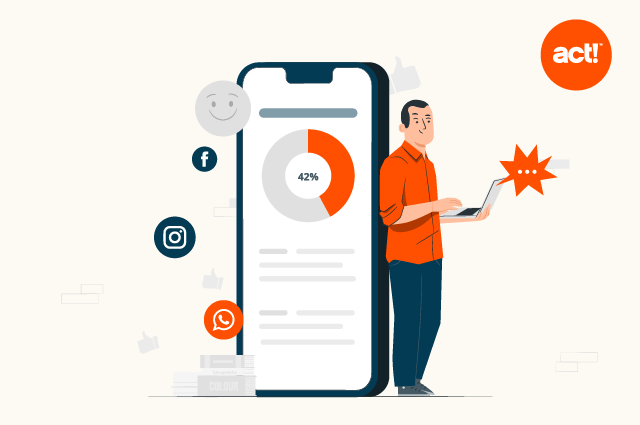
Blackberry, Nokia, Kodak, Toys-R-Us — what’s common among these companies who were once giants in their industries? They failed to innovate and evolve with changing market dynamics. As a result, their competitors left them behind.
If you don’t want that to happen to your business, you must keep an eye on the fast-changing marketing trends in your industry and use emerging media and technology for effective communication and brand positioning.
In 2023, that means keeping an eye on important new trends like artificial intelligence, video marketing, automation, and more. Read on to see some of the biggest trends you can’t ignore that show where marketing is headed in 2023.
1. Artificial intelligence

In 2022, AI went mainstream with ChatGPT and Dall.E 2. But 2023 is the year AI will begin to transform every aspect of business and marketing forever. According to forecasts, the global AI market is expected to exceed $1.8 billion by 2030.
AI empowers marketing teams with small budgets to do things that cost thousands of dollars and require high technical expertise. For example, they can use it to create human-like presenters for videos or webinars, build realistic voiceovers, and automate content creation for content marketing or digital marketing campaigns. You can turn your imagination into high-quality images, build landing pages and websites, and, above all, improve your user experience by communicating with your audience and understanding your potential customer’s needs better than ever.
It also helps you cut costs, automate repetitive work, and find innovative solutions to complex problems. For example, AI can help you automate customer service by addressing your most frequent customer issues through chatbots. Similarly, it can help you optimise your advertising spending by identifying your most profitable channels.
In short, AI will only improve with time, and the businesses that see it as a facilitator rather than a competitor will set themselves up to thrive.
2. Short video content
Video is the perfect storytelling platform because it’s inherently engaging. It is already the most popular digital content type, and nearly 70 percent of marketers say it drives the highest conversions and is key to their content strategies.
But the video marketing landscape has changed drastically over the last few years with the rise of TikTok, Snapchat, and other short-video platforms. Studies show that viewers watch nearly all short-form videos for over 40% of their duration, while 30% of videos have an average watch duration of over 81%. This has forced YouTube and Facebook to introduce Shorts and Reels, their own versions of TikTok-style short videos.
As a business owner, you can benefit from this trend by investing more resources in creating short-quality content videos for TikTok, YouTube, Facebook, and other social media platforms.
Shorter content not only drives more engagement but is also more addictive. It helps you retain viewers longer, resulting in greater brand awareness.

3. Personalisation
Your target audience is bombarded with advertisements, notifications, and marketing messages from all directions. If you want them to notice you and take an interest in your offers, you must personalise your messaging strategy. According to one study, 47% of marketers say personalised marketing has an ROI of $3-10 for every dollar spent, while 22% believe it returns $11 or more for every dollar.
What’s personalisation? Tailoring your message, offers, and communication to your audience’s needs.
For example, when a user lands on your e-commerce store, show them a tailored product listing based on their interests and purchase history. Similarly, you can use dynamic content for landing pages and emails to address your subscribers by name and share content designed for their needs.
Amazon is an excellent example of e-commerce personalisation, as it uses algorithms including your browsing history and previous activity on its platform to suggest relevant products.

4. Marketing automation
Marketing automation has been among the hottest digital marketing strategy trends over the past few years. But with the recent AI advancements you can expect during this and next year to see a new wave of marketing automation tools helping businesses increase productivity, reduce costs, increase SEO rankings, improve customer retention, and generate higher sales.
Automation can be used for a range of digital marketing tactics, including email marketing, landing page conversion rates, website personalization, social media marketing, and customer data management.
For example, using Act!, you can automate your email marketing, create personalised landing pages for lead generation, and use customer relationship management (CRM) features to save customer data. As a result, you can segment your customers more efficiently, track leads easily, and resolve customer issues by connecting them with the right support agents.
In short, if you want to scale your business while drastically reducing costs, marketing automation is the way to go.
5. Omnichannel marketing
Customers expect brands to offer a seamless transition between different platforms while they’re searching for products and services. For example, it’s common for shoppers to switch between desktop and mobile devices while searching for products on a brand’s website. But many such buyers end up purchasing the product in a physical store.
By providing an omnichannel marketing experience, brands can ensure that customers can continue their product search on any device without disrupting the brand experience.
This is no longer optional. According to studies, 45 percent of shoppers expect in-store sales staff to be knowledgeable about products on the brand’s website or social media accounts.
Omnichannel applies to other areas of your business as well. For example, customers prefer connecting with the same support agent, regardless of the channel they use. This not only helps you offer a consistent customer experience but also gathers priceless customer behavioral data to optimize your marketing strategy.
6. Brand storytelling
One of the biggest challenges for businesses in the age of AI content is standing out and connecting with customers authentically. The only solution to this is to build a strong brand personality with a compelling story behind it. Many businesses are forging partnerships with influencers to help amplify their brand and narrative. Others are publishing user-generated content where their customers share their experience, usually via video, with your brand.
Your customers must be able to relate to your brand beyond your services. There must be a higher purpose that connects you with your audience and sets you apart in a market where it’s increasingly difficult to differentiate between robots and humans.
So, ask yourself the reason your brand exists beyond profits. For example, some businesses align with social causes like sustainability, veganism, or racial equality. This makes your brand memorable and helps you create a stronger bond with your audience.
What latest marketing trends are you following?
Following trends doesn’t mean you must completely alter your brand’s trajectory or compromise your core beliefs. Instead, you can stay true to your brand values while incorporating new digital marketing trends that benefit your business. Following these trends will help you keep up with the competition and strengthen your connection with your audience.





